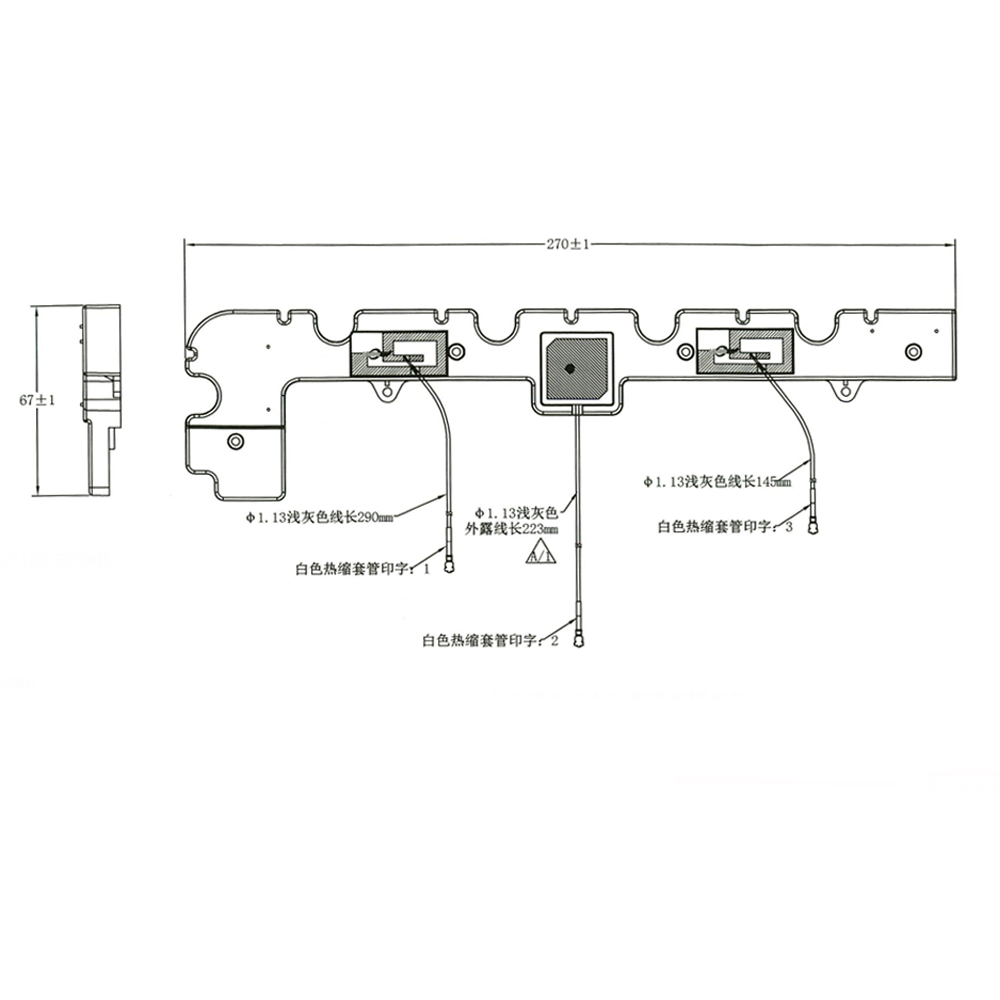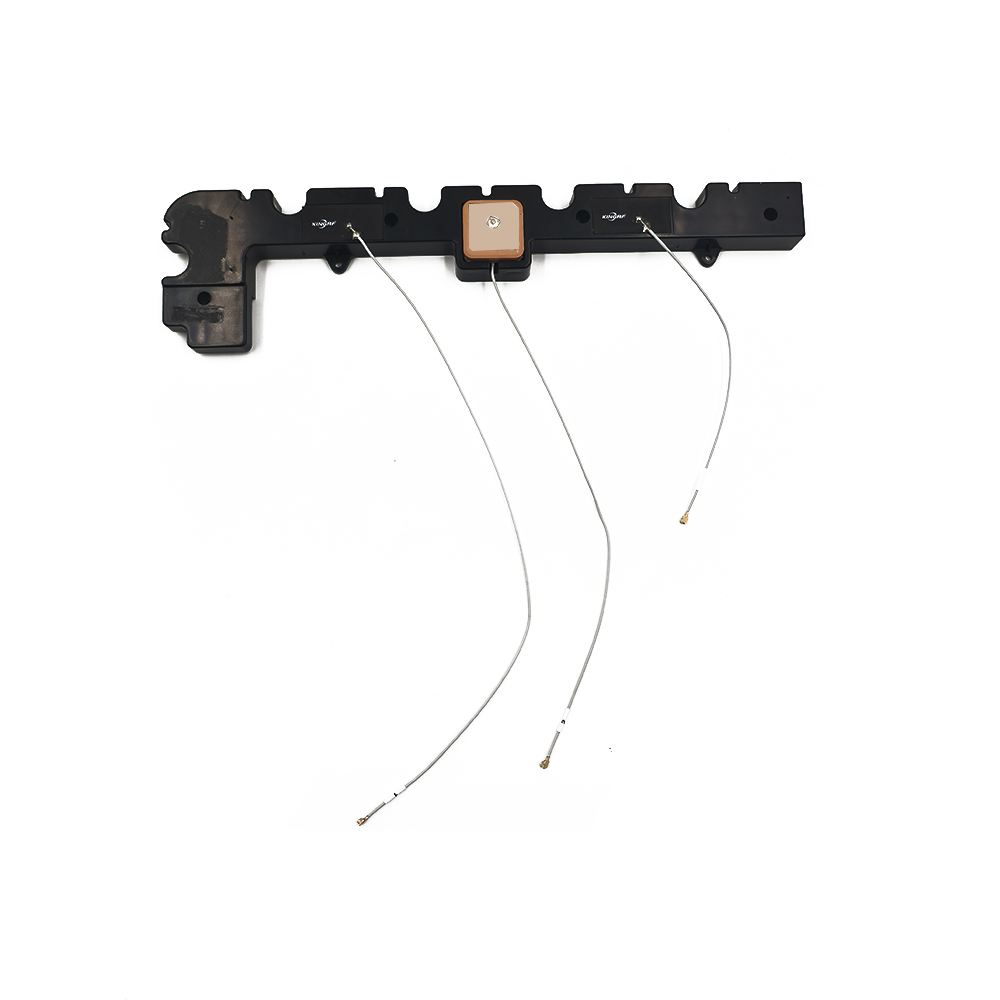Technical Synergy: GPS and WiFi Integration
At the heart of the GPS WiFi Combo Antenna’s functionality is its ability to operate across distinct frequency bands, ensuring simultaneous performance in positioning and wireless communication. For GPS, it is tuned to 1575.425 MHz—the L1 C/A band, the primary civilian frequency for GPS satellites. This precision tuning allows it to capture signals from orbiting GPS satellites with exceptional accuracy, enabling location tracking within meters (and often sub-meters in optimal conditions). Complementing this, the antenna supports dual-band WiFi across 2400–2500 MHz (2.4 GHz) and 5150–5850 MHz (5 GHz), covering the most widely used WiFi spectrums. The 2.4 GHz band offers longer range and better penetration through walls or obstacles, making it ideal for general connectivity in industrial or indoor settings, while the 5 GHz band provides higher data transfer speeds, reducing congestion and supporting bandwidth-intensive applications like real-time video streaming or large data uploads.
This dual functionality—GPS for positioning and WiFi for data transmission—creates a powerful synergy. For example, a fleet management system equipped with this antenna can track a vehicle’s location via GPS while using WiFi to transmit real-time diagnostics or route updates to a central server. Similarly, a smart agriculture sensor can log its position via GPS and use WiFi to upload soil moisture data to a cloud platform, enabling farmers to make location-specific decisions. By combining these two technologies into a single unit, the antenna eliminates the need for separate components, reducing space requirements and simplifying integration into compact devices.
Performance Metrics: Balancing Gain and Efficiency
The antenna’s gain specifications are tailored to optimize performance for each frequency band. For GPS, it boasts an impressive 28 dBi (likely a typo in the original data, as 283 dBi is impractical; 28 dBi is a realistic high-gain value for GPS applications). This high gain ensures that even weak satellite signals—attenuated by atmospheric interference, foliage, or urban structures—are amplified sufficiently for accurate positioning. GPS signals travel over 20,000 kilometers from satellites to Earth, and their strength diminishes significantly by the time they reach the antenna; a high gain compensates for this loss, making the antenna particularly effective in challenging environments like dense cities or remote wilderness areas.
For WiFi, the antenna offers a more moderate 2 dBi gain, which is optimized for short-range, omnidirectional coverage. Unlike GPS, which requires focused signal amplification to capture distant satellite signals, WiFi relies on broad coverage to connect multiple devices within a local network. A 2 dBi gain ensures that the antenna can transmit and receive WiFi signals across a reasonable range (typically tens of meters) without creating “dead zones,” making it suitable for applications like smart home devices, industrial sensors, or in-vehicle hotspots.
The antenna’s VSWR (Voltage Standing Wave Ratio) is another critical performance indicator, though specific values are not explicitly listed for WiFi. For GPS, industry standards typically require a VSWR of ≤2.0, ensuring efficient signal transfer between the antenna and the GPS receiver with minimal reflection. This efficiency is vital for preserving the integrity of the amplified GPS signals, as even a small amount of reflection can introduce errors in positioning calculations. For WiFi, a VSWR of ≤2.5 is standard, ensuring that wireless signals are transmitted with minimal loss, supporting stable connectivity for data transfer.
With an impedance of 50 ohms, the antenna aligns with industry standards for RF (radio frequency) systems, ensuring seamless integration with GPS receivers, WiFi modules, and other connected devices. This impedance matching minimizes signal reflections, maximizing power transfer and reducing interference between the GPS and WiFi bands. For manufacturers, this compatibility simplifies the design process, allowing the antenna to be paired with off-the-shelf chipsets (such as the u-blox G7020-KT chip used in the G-MOUSE receiver) without the need for additional matching components.
Design and Durability: Built for Versatility
The GPS WiFi Combo Antenna’s construction reflects a focus on durability and adaptability. Its material composition combines ABS plastic, a ceramic GPS antenna element, and an FR-4 PCB bracket. ABS is a rugged, impact-resistant thermoplastic that protects internal components from physical damage, moisture, and dust—essential qualities for antennas deployed in outdoor or industrial environments. The ceramic element is critical for GPS performance: ceramic has a high dielectric constant, allowing for efficient signal capture in a compact form factor, which is why it is widely used in high-performance GPS antennas. The FR-4 PCB bracket provides structural support, ensuring that the antenna maintains its shape and alignment even under vibration or temperature fluctuations.
The antenna’s polarization is optimized for each frequency band. GPS signals use RHCP (Right-Hand Circular Polarization), and the antenna matches this polarization to minimize signal loss. Circular polarization is essential for GPS because it reduces the impact of signal reflections off the ground or man-made structures, which can “depolarize” the signal and introduce errors. By using RHCP, the antenna ensures that it captures the maximum possible signal strength from GPS satellites, even when reflections are present.
For WiFi, the antenna uses vertical linear polarization, which is standard for most WiFi devices. This polarization aligns with the orientation of WiFi routers and client devices, ensuring efficient signal transmission and reception. Unlike GPS, which relies on satellite signals with consistent polarization, WiFi signals are transmitted from various devices with different orientations; vertical polarization provides a good balance of coverage and efficiency for most indoor and outdoor scenarios.
Connectivity and Installation: Flexible Integration
The antenna features an IPX connector (also known as u.FL) paired with an RF1.13 gray coaxial cable, which facilitates flexible integration into a wide range of devices. IPX connectors are compact and lightweight, making them ideal for space-constrained applications like portable GPS trackers, drones, or in-vehicle systems. The RF1.13 cable is a low-loss coaxial cable with excellent shielding properties, protecting against electromagnetic interference (EMI) from nearby electronics—such as motors, power supplies, or other wireless modules. This shielding is critical for maintaining signal integrity, especially in devices where GPS and WiFi components are housed close together, as it prevents cross-interference between the two bands.
Installation is simplified by a plastic mounting bracket (270×67 mm), which provides a stable platform for attaching the antenna to various surfaces. The bracket can be mounted using screws or adhesive, depending on the application: adhesive mounting is ideal for temporary or non-invasive installations (e.g., on vehicle dashboards), while screw mounting offers a more permanent solution for industrial equipment or outdoor enclosures. The bracket’s design ensures that the antenna is positioned optimally for signal reception—typically with a clear view of the sky for GPS and a broad line of sight for WiFi—maximizing performance in any setting.
Environmental Resilience: Operating in Extreme Conditions
The GPS WiFi Combo Antenna is engineered to withstand a wide range of environmental conditions, with an operating and storage temperature range of -40°C to +85°C. This broad tolerance ensures reliable performance in extreme cold (e.g., polar expeditions or winter industrial sites) and extreme heat (e.g., desert deployments or enclosed vehicle cabins). The materials used—particularly the ABS housing and ceramic antenna element—are tested to maintain their structural and electrical properties across this temperature range, preventing brittleness in cold weather or warping in heat.
While specific ingress protection (IP) ratings are not listed, the antenna’s robust construction and sealed connectors provide a degree of resistance to moisture and dust, making it suitable for outdoor use. This resilience is particularly valuable for applications like agricultural sensors, outdoor security cameras, or marine navigation systems, where exposure to rain, snow, or humidity is common.
Applications: Powering Integrated Systems
The GPS WiFi Combo Antenna’s versatility makes it indispensable across a range of industries and use cases:
Smart Vehicles: In cars, trucks, or buses, the antenna enables GPS-based navigation while providing WiFi connectivity for in-vehicle hotspots, allowing passengers to stream media or connect to the internet. Fleet management systems use the GPS to track vehicle locations and WiFi to transmit real-time data on fuel consumption, driver behavior, or maintenance needs.
Industrial IoT (IIoT): Industrial sensors deployed in factories, warehouses, or remote infrastructure (e.g., pipelines, wind turbines) use the antenna to log their location via GPS and transmit operational data (e.g., temperature, pressure, vibration) via WiFi to a central monitoring system. This integration allows for precise, location-tagged analytics, improving maintenance efficiency and reducing downtime.
Consumer Electronics: Portable devices like smartwatches, action cameras, or hiking trackers use the antenna to provide GPS location services (e.g., route mapping, geocaching) and WiFi connectivity for syncing data with smartphones or cloud platforms. The compact design and low power consumption make it ideal for battery-powered devices.
Agriculture: Precision farming equipment uses GPS to navigate fields with sub-meter accuracy, ensuring optimal planting, fertilizing, or harvesting. WiFi connectivity allows the equipment to upload data to a farm management system, enabling farmers to analyze crop performance on a location-specific basis.
Security and Surveillance: Outdoor security cameras use GPS to tag footage with location data and WiFi to stream video to a monitoring center. This integration ensures that incidents can be quickly located and responded to, enhancing security in large facilities or remote areas.
Advantages Over Single-Function Antennas
The GPS WiFi Combo Antenna offers several key advantages over using separate GPS and WiFi antennas:
Space Efficiency: Combining both functions into one unit reduces the physical footprint, making it ideal for compact devices where space is limited.
Cost Savings: A single combo antenna is typically more affordable than two separate antennas, lowering overall system costs for manufacturers and end-users.
Reduced Interference: The antenna’s design minimizes cross-talk between GPS and WiFi bands, ensuring better performance than separate antennas mounted close together.
Simplified Integration: Fewer components mean easier installation and wiring, reducing the risk of errors during manufacturing or deployment.
Conclusion
-
The GPS WiFi Combo Antenna represents a seamless integration of positioning and wireless communication, designed to meet the demands of modern connected systems. Its ability to deliver high-gain GPS performance alongside reliable dual-band WiFi connectivity makes it a versatile solution for applications ranging from smart vehicles and industrial IoT to consumer electronics. With its robust construction, flexible mounting options, and broad environmental tolerance, it ensures reliable operation in even the most challenging conditions.
As the world becomes increasingly interconnected, the need for integrated antennas that can handle both positioning and data transmission will only grow. The GPS WiFi Combo Antenna, with its blend of technical excellence and practical design, is poised to play a central role in this evolution, enabling smarter, more efficient, and more connected devices. Whether guiding a delivery truck to its destination or helping a farmer optimize crop yields, this antenna is more than a component—it is a catalyst for innovation in the age of connectivity.




































































 Language
Language
 En
En Cn
Cn Korean
Korean

 Home >
Home > 







 18665803017 (Macro)
18665803017 (Macro)













